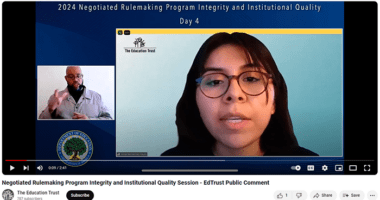A Next-Generation Design for Federal Financial Aid
This morning, we’ll be hosting a panel discussion about better targeting federal financial aid, work-study dollars, and other funding to more effectively benefit students and taxpayers. It’s a culmination of four policy proposals released this year (from four entities, Ed Trust included) that provide policy recommendations for creating a next-generation design for our nation’s financial aid system.
All of the work is wrapped up in Beyond Pell, the paper we’re releasing today and discussing at the event. Beyond Pell pushes for a 10 percent affordability guarantee for low-income students — meaning that any student who is eligible for a maximum Pell Grant (those from families with incomes of $23,000 or less) should not have to pay more than 10 percent of family income each year to go to college. (Currently, maximum Pell Grants are $5,645, so any remaining tuition, fees, or other academic expenses are paid for out-of-pocket.)
The paper outlines three ways that the federal government, states, and institutions can do this:
- A New Federal Block Grant Program. Federal matching grants could be given to states that are providing student operating support at a level equal to between 50 percent and 150 percent of the maximum Pell Grant (currently $2,823 and $8,468).
- A Pell Grant Matching Program. Institutions that create an affordability guarantee would get additional Pell Grant funding, above what institutions without the guarantee receive.
- A New, Flexible Federalism for Higher Education. States would have to maintain an affordability guarantee in order to receive federal funding for higher education. They could do this by increasing their own funding to institutions, mandating the guarantee, or creating their own need-based financial aid programs.
For more details on this proposal or to learn more about the four policy papers released this year, dig into Beyond Pell. If you’d like to join the discussion today, follow along on Twitter via #BeyondPell.













